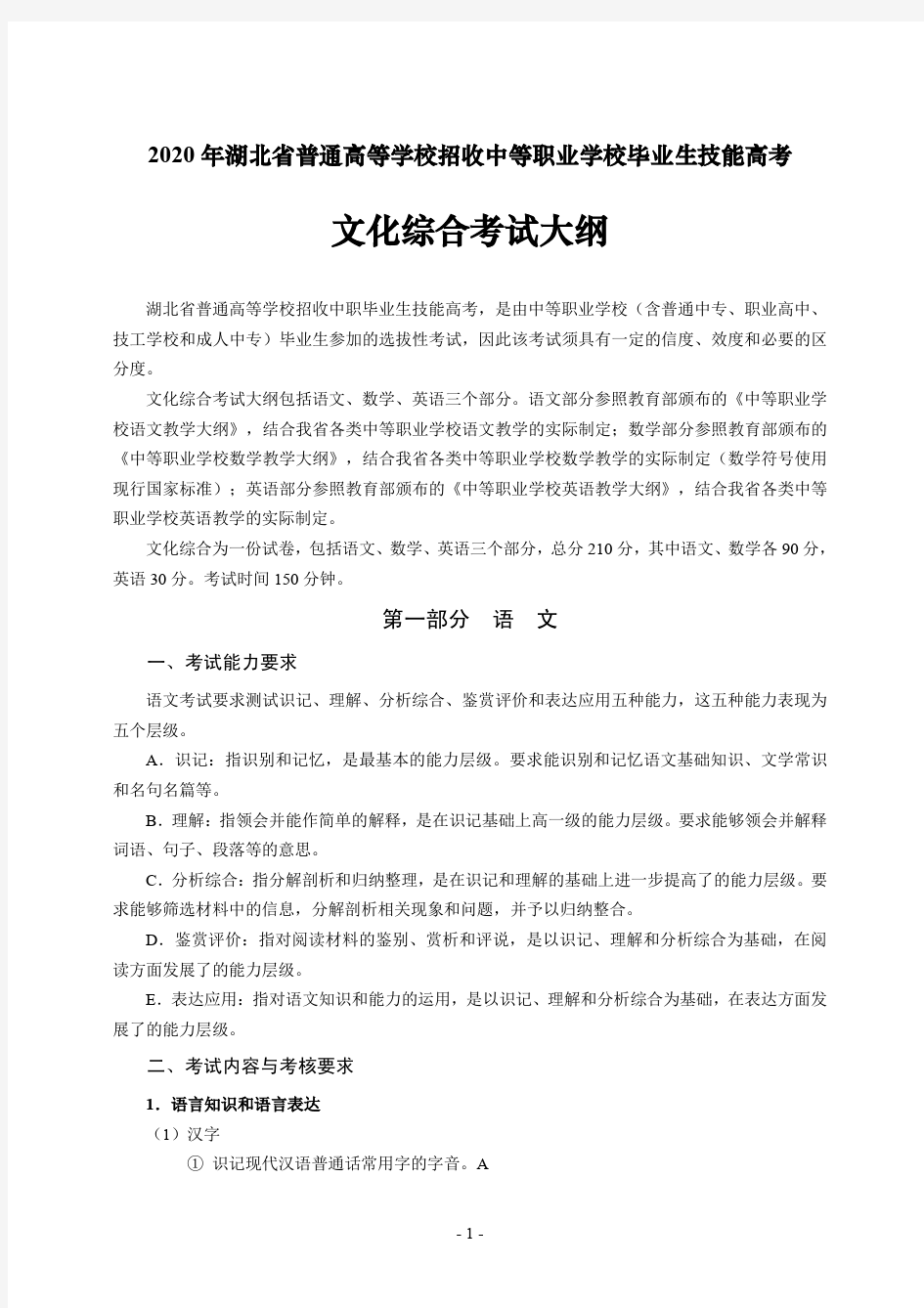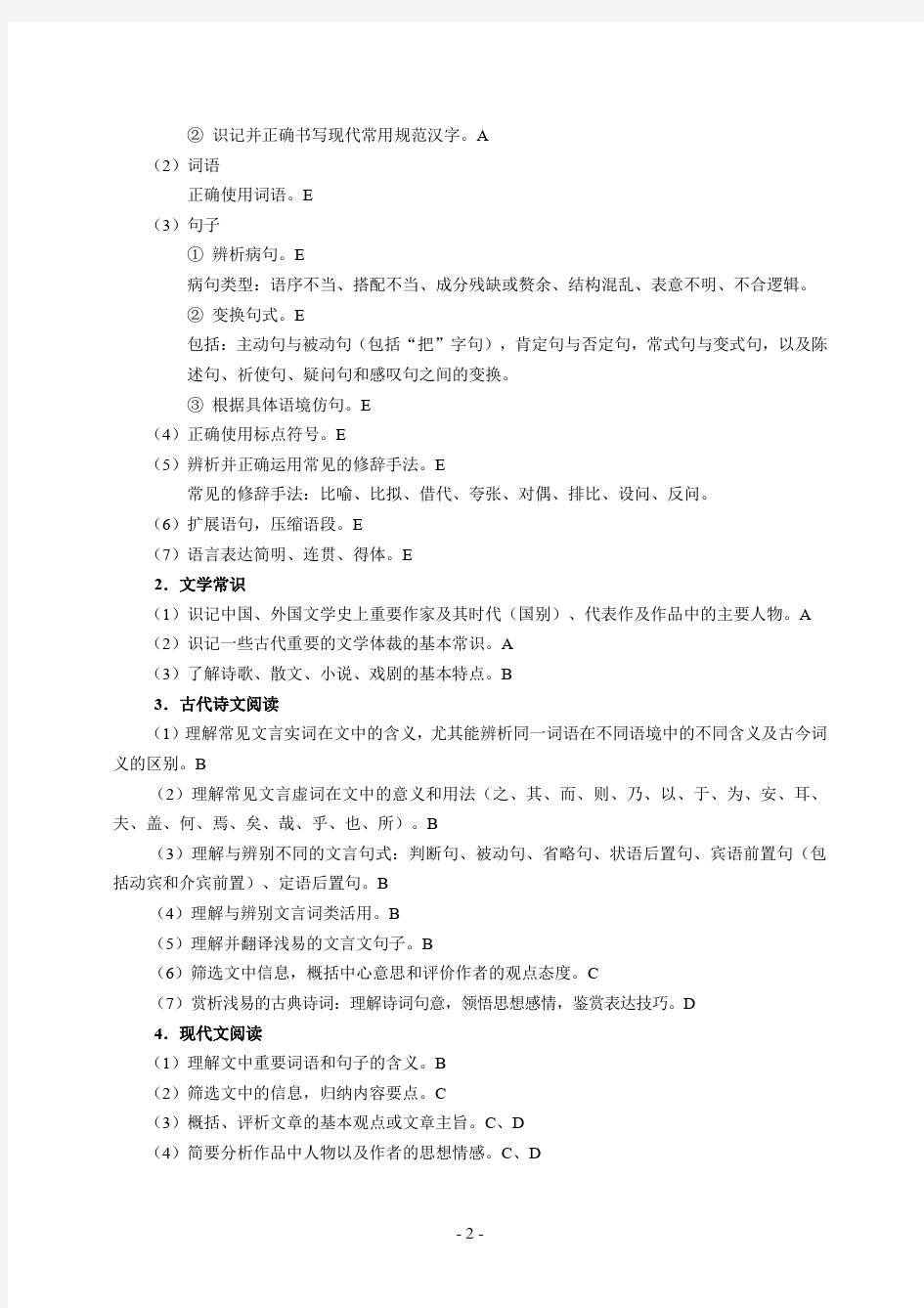文化综合考试大纲


历史课程标准2011版
义务教育 历史课程标准 (2011 年版) 中华人民共和国教育部制定 第一部分前言 一、课程性质 二、课程基本理念 三、课程设计思路第二部分课程目标第三部分课程内容 一、中国古代史 二、中国近代史 三、中国现代史 四、世界古代史 五、世界近代史 六、世界现代史 第四部分实施建议 一、教学建议 二、评价建议 三、教材编写建议 四、课程开发与资源利用建议 第一部分前言 当今世界正在发生广泛而深刻的变化,当代中国正在发生广泛而深刻的变革。全面建设小康社会,加快推进社会主义现代化是时代赋予中国人民的崇高使命。培育具有社会主义核心价值观的公民,是时代发展和社会前进的需求,也是青少年自身成长和全面发展的要求。这对义务教育阶段历史课程的改革提出了新的要求。 历史教育对提高学生的人文素养有着重要的作用。义务教育阶段的历史课程,是在唯物史观的指导下,弘扬以爱国主义为核心的民族精神和以改革创新为核心的时代精神,传承人类文明的优秀传统,使学生了解和认识人类社会的发展历程,更好地认识当代中国和当今世界。学生通过历史课程的学习,初步学会从历史的角度观察和思考社会与人生,从历史中汲取智慧,逐步树立正确的世界观、人生观和价值观,提高综合素质,得到全面发展。 一、课程性质 历史课程是人文社会科学中的一门基础课程,对学生的全面发展和终身发展有着重要的意义。义务教育阶段7~9年级的历史课程在基础教育中占有重要的地位,主要具有以下特性: 思想性坚持用唯物史观阐释历史的发展与变化,使学生认同中华民族的优秀文化传统,增强该国主义情感,坚定社会主义信念,拓展国际视野,逐步树立正确的世界观和人生观。 基础性根据学生的心理特征和认知水平,以普及历史常识为主,引领学生掌握基本的、重要的历史知识和技能,逐步形成正确的历史意识,为学生进一步学习与发展打下基础。 人文性以人类优秀的历史文化陶冶学生的心灵,帮助学生客观地认识历史,正确理解人与社会、人与自然的关系,提高人文素养,逐步形成正确的价值取向和积极向上的人生态度,适应社会发展的需要。 综合性注重人类历史不同领域发展的关联性,注重历史与现实的关系,使学生逐步学会综合运用所学知识和方法对历史和社会进行全面的认识。
文化生活课程标准和考试大纲
文化生活课程标准和考试大纲
文化生活课程标准和考试大纲
普通高中政治课程标准(实验) 第一部分前言 我国已进入全面建设小康社会、加快推进社会主义现代化的新的发展阶段。随着改革开放和社会主义市场经济的发展,社会经济成分、组织形式、就业方式、利益关系和分配方式日益多样化,给人们的思想观念带来深刻影响;世界多极化和经济全球化趋势,日新月异的科技进步,使我国的发展面临着前所未有的挑战与机遇,这对高中学生的思想政治素质提出了新的更高要求。为此,思想政治课教学必须贯彻党的十六大精神,以邓小平理论和“三个代表”重要思想为指导,着眼于当代社会发展和高中学生成长的需要,增强思想政治教育的时代感、针对性、实效性和主动性。 依据中央关于学校德育工作的有关文件和《国务院关于基础教育改革与发展的决定》及教育部《普通高中课程方案(实验)》,制订本课程标准。 一、课程性质 高中思想政治课进行马克思列宁主义、毛泽东思想、邓小平理论和“三个代表”重要思想的基本观点教育,以社会主义物质文明、政治文明、精神文明建设常识为基本内容,引导学生紧密结合与自己息息相关的经济、政治、文化生活,经历探究学习和社会实践的过程,领悟辩证唯物主义和历史唯物主义的基本观点和方法,切实提高参与现代社会生活的能力,逐步树立建设中国特色社会主义的共同理想,初步形成正确的世界观、人生观、价值观,为终身发展奠定思想政治素质基础。 高中思想政治课与初中思想品德课和高校 政治理论课相互衔接,与时事政策教育相互补充,与高中相关科目的教学和其他德育工作相互配合,共同完成思想政治教育的任务。 二、课程的基本理念
(一)坚持马克思主义基本观点教育与把握时代特征相统一 本课程要讲述马克思主义的基本观点,特别是邓小平理论和“三个代表”重要思想,紧密联系我国社会主义现代化建设的实际,与时俱进地充实和调整教学内容,体现当今世界和我国发展的时代特征,显示马克思主义科学理论的强大力量。 (二)加强思想政治方向的引导与注重学生成长的特点相结合 本课程要重视高中学生在心理、智力、体能等方面的发展潜力,针对其思想活动的多变性、可塑性等特点,在尊重学生个性差异和各种生活关切的同时,恰当地采取释疑解惑、循循善诱的方式,帮助他们认同正确的价值标准、把握正确的政治方向。 (三)构建以生活为基础、以学科知识为支撑的课程模块 本课程要立足于学生现实的生活经验,着眼于学生的发展需求,把理论观点的阐述寓于社会生活的主题之中,构建学科知识与生活现象、理论逻辑与生活逻辑有机结合的课程模块;在开设必修课程的同时,提供具有拓展性和应用性的选修课程,以满足学生发展的不同需要。 (四)强调课程实施的实践性和开放性 本课程要引领学生在认识社会、适应社会、融入社会的实践活动中,感受经济、政治、文化各个领域应用知识的价值和理性思考的意义;关注学生的情感、态度和行为表现,倡导开放互动的教学方式与合作探究的学习方式;使学生在充满教学民主的过程中,提高主动学习和发展的能力。 (五)建立促进发展的课程评价机制 本课程要改变过分注重知识性和单一的纸笔测验的评价方式,立足思想政治素质的提高,建立能够激励学生不断进步的评价机制。既要考评学生掌握和运用相关知识的水平和能力,更要
面向普高毕业生文化综合考试大纲
2014 年武汉铁路职业技术学院单独招生 面向普高毕业生文化综合考试大纲 数学部分 一、考试目标与要求数学科考旨在测试中学数学基础知识、基本技能、基本方法,考查逻辑思 维能力、运算能力、空间想象能力,以及运用所学数学知识和方法分析问题和解决问题的能 力。考试内容的知识要求和能力要求作如下说明:1.知识要求 本大纲按照认知要求从低到高分为如下三个层次:基本了解:要求考生对所列知识的含义有初步的认识,识记有关内容,并能进行直接运用。 全面掌握:要求考生对所列知识的含义有较深的认识,能够解释、举例或变形、推断,并能运用知识解决有关问题。 灵活运用:要求考生对所列知识能够综合运用,并能解决较为复杂的数学问题。2.能力要求逻辑思维能力:会对问题进行观察、比较、分析、综合、抽象与概括;会用演绎、归纳和类比进行推理;能准确、清晰、有条理地进行表述。 知识运用能力:理解算理,会根据法则、公式、概念进行数、式、方程的正确运算和变形;能分析条件,寻求与设计合理、简捷的运算途径;能根据要求对数据进行估计,能运用计算器进行数值计算。 空间想象能力:能根据条件画出图形,根据图形想象出直观形象;能正确地分析出图形中基本元素及其相互关系;能对图形进行分解、组合、变形。
分析问题和解决问题的能力:能阅读理解对问题进行陈述的材料;能综合应用所学数学知识、思想和方法解决问题,包括解决在相关学科、生产、生活中的数学问题,并能用数学语言正确地加以表述。 二、考试内容与考试要求 (一)集合 1.理解集合、元素、空集、常用数集、交集、并集的概念; 2.掌握集合的列举和描述这两种表示法;掌握集合与元素的关系、集合与集合的关系;掌握集合的交和并运算。 (二)不等式和不等式组 1.理解不等式的性质,会用不等式的性质和基本不等式如a20(a R)、a2 b2 2ab(a,b R)、解决一些简单问题。 2.会解一元一次不等式,一元一次不等式组和可化为一元一次不等式组的不等式,会解一元二次不等式,了解区间的概念,会在数轴上表示不等式或不等式组的解集。 3.了解绝对值不等式的性质,会解形如|ax b c和ax b c的绝对值不等式。 (三)数、式及方程、方程组 1.理解有理数、实数及数轴、相反数、绝对值、倒数、算术平方根的概念,会进行 有关计算 2.理解有关整式、分式、二次根式的概念,掌握它们的一些性质和运算法则。 3.掌握一元一次方程,一元二次方程的解法,能运用一元二次方程根的判别以及根与系数的关系解决有关问题。
最新欧洲文化入门复习资料
Part I Directions: Read the following unfinished statements or questions carefully. For each unfinished statement or question, four suggested answers marked [ A ], [ B ], [ C ] and [ D] are given. Choose the one which best completes the statement or answers the question by blackening the corresponding letter on the ANSWER SHEET. ****** 1 ****** 1. _________ believed that the highest good in life was pleasure, freedom from pain and emotional upheaval. A. Sophists B. Cynics C. Skeptics D. Epicureans 2. _________ is said to have told the king of Syracuse: "Give me a place to stand, and I will move the world." A. Archimedes B. Aristotle C. Plato D. Euclid 3. Increasingly troubled by the inroads of northem tribes such as Goths, the West Roman Empire finally collapsed in _________ A. 395 B. 27 C. 1453 D. 476 4. The City of God was written by ________, the most important of all the leaders of Christian thought. A. Jesus B. Augustine C. Thomas Aquinas D. Martin Luther 5. _________ was a painter, a sculptor, an architect, a musician, an engineer, and a scientist----- a Renaissance man in the true sense of the word. A. Michelangelo B. Raphael C. Shakespeare D. Leonardo Da Vinci 6. In _______, Cervantes satirized a very popular type of literature at the time, the romance of chivalry. A. Don Quixote B. Hamlet C. Leviathan D. The Life and Surprising Adventures of Robinson Crusoe 7. The best- known book written by Thomas More is ________ , which describes an ideal non-Christian state where everybody lives a simple life and shares the goods in common, possesses a good knowledge of Latin, fights no war and enjoys full freedom in religious belief. A. The Praise of the Folly B. As You Like It C. Divine Comedy D. Utopia 8. ________, author of Prince, is regarded as "father of political science" in the West. A. Machiavelli B. Dante C. Bacon D. Locke
中国文化概论课程标准
《中国文化概论》课程标准 课程编号:131024 课程总学时:40 课程学分:2.5 课程类别:专业选修课 适用专业:文秘 制定单位:人文学院 制定时间:2014年7月 一、课程总述 1.课程性质 本课程是文秘专业的一门专业选修课程,是一门兼顾历史的关于中国国别文化的基础知识和基本理论课程。主要让学生比较全面地了解中国悠久而丰富的文化内容,扩展知识,理清脉络,进一步认识中国文化的基本特征,在此的基础上,引发学生思考中国文化的继承和创新问题,提高学生的人文素质,增强学生的民族自信心、自尊心、自豪感,培养高尚的爱国主义情操。本课程无先导与后续课程,与古代文学、古代汉语、中国秘书史等课程在内容上有较多关联。 2.课程设计思路 现代秘书必须具备具有较高的人文素养和职业素养,需要了解与吸收中国传统文化方面知识营养,了解秘书工作产生与生产的文化大环境,增强民族自信心、自尊心、自豪感,养成高尚的道德情操和爱国主义情怀,这是设置本门课程的理论依据。中国传统文化绵延时间长,覆盖面广,理论性强,知识系统性强,在教学过程中以理论教学为主,可辅以社会调查、专业考察等形式,以加深学生对所学知识的理解。在教学组织与安排上可以以讲授、讨论、案例分析相结合的方式进行。 3.课程目标 课程总体目标:通过本课程的学习,使学生比较全面地了解中国悠久而丰富的文化内容,扩展知识,理清脉络,进一步认识中国文化的基本特征;在了解、认识中国文化的基础上,引发学生思考中国文化的继承和创新问题;提高学生的人文素质,增强学生的民族自信心、自尊心、自豪感,培养高尚的爱国主义情操。本课程的任务是使大学生对中华民族数千年的灿烂文化成就有一个宏观的、明确的把握,从而引发他们关心和思考对中国文化的继承、创新和发展问题以及中华民族的前途和命运问题。
文化基础(语文数学综合)考试大纲
河南水利与环境职业学院2018年单独考试招生 文化基础(语文数学综合)考试大纲 第一部分考试性质 我院单独招生文化基础(语文数学综合)考试是由中等职业学校相关专业毕业生和无学业水平考试成绩或学业考试成绩不合格的普通高中毕业生参加的自主选拔性考试。 第二部分考试形式与试卷结构 一、考试形式、时间及分值 考试形式:闭卷、笔试; 考试时间:120分钟; 试卷满分:150分,其中:语文90分、数学60分。 二、试卷结构 1.试题难度及比例: 试题易中难比例为7﹕2﹕1。容易题占70%,中难题占20%,稍难题占10%。 2.题型: 语文:填空题,选择题,作文题。 数学:全部为单项选择题。 第三部分考试依据、目标要求、范围及内容 一、语文部分 考试依据:本考试大纲以教育部颁发的《中等职业学校语文教学大纲》为依据,结合我省中等职业学校语文教学的实际情况和高等职业院校专业培养需要,考核学生正确理解和运用祖国语言文字的能力,提高科学文化素养,以适应就业和创业的需要而制定。在考查考生语文基础知识、基本技能掌握程度的基础上,重在测试理解和运用祖国语言文字的能力。内容范围包括语文基础知识及运用、现代文阅
读、文言文阅读、口语交际、语文综合实践活动等方面,以现代文和文言文阅读分析能力的测试为重点。 考试目标要求:语文考试要求考查考生识记、理解、分析、应用能力。 (一)识记:指识别和记忆,是最基本的能力层级。 (二)理解:指领会并能作简单的解释,是在识记基础上高一级的能力层级。 (三)分析:指对文本进行深入剖析,揭示各部分间的内在联系,是在识记和理解的基础上进一步提高了的能力层级。 (四)应用:指对语文知识和能力的综合运用,包括评价、探究和实践能力,是以识记、理解和分析为基础,在阅读和表达方面发展了的能力层级。 1.评价:指对阅读材料能有独到的见解、观点、意见、感想、感悟、体会等,是在识记、理解、分析的基础上进一步提高了的能力层级。 2.探究:指对某些问题进行探讨,有发现、有见解、有创新,是在识记、理解、分析、评价的基础上进一步提高了的能力层级。 3.实践:指能根据设置的活动要求,查找、搜集和整理资料,综合运用语文知识解决学习、生活和职场工作中的具体问题,是在识记、理解、分析、评价、探究的基础上进一步提高了的能力层级。 考试范围及内容: (一)语文基础知识及运用 1.识记常用汉字的音、形、义。 2.正确使用常见词语(包括成语),结合语境辨析词语的意义和色彩。 3.辨析成分残缺或赘余、搭配不当、语序不当、结构混乱和表意不明、不合逻辑等常见语病。 4.正确使用标点符号。 5.辨析比喻、拟人、夸张、排比、反复、对比、对偶、设问、反问、引用等常见修辞手法,理解其表达作用。
欧洲文化入门复习资料
1、Two major elements in European culture:the Greco-Roman element and the Judeo-Christian element. 2、The Homer epics consists of the Iliad and the Odyssey. The Iliad deals with the alliance of the states of the southern mainland of Greece,led by Agamemnon in their war against the city of Troy. The heroes are Hector on the Trojan side and Achilles and Odysseus on the Greek. In the final battle,Hector was killed by Achilles and Troy was sacked and burned by the Greeks. The Odyssey deals with the return of Odysseus after the Trojan war to his home island of Ithaca. It describes many adventures he ran into on his long sea voyage and how finally he was reunited with his faithful wife Penelope. 3、古希腊三大悲剧家:Aeschylus, Sophocles, Euripides Works of Aeschylus:Prometheus Bound,Persians,and Agamemnon .There are only two actors and one chorus in these plays. Aeschylus is noted for his vivid character portrayal and majestic poetry.Works of Sophocles:Oedipus the King,Electra,and Antigone (theme:the difficult choice between public duty and private feeling). He has had a great impact on European culture. The Oedipus complex(恋母情结)、Electra(恋父情结)were derived from his plays Work of Euripides:Andromache,Medea,and Trojan Women. He was more of a realist than other two. His characters are less heroic,more like ordinary people. He may be called the first writer of “problem plays” 4.Herodotus is often called “Father of History”,wrote about the wars between Greeks and Persians . His history is full of anecdotes and digressions and lively dialogue. 5.Thucydides is more accurate as an historian. He told about the war between Athens and Syracuse ,a Greek state on the island of Sicily. He traced events to their causes and brought out their effects. Macaulay called Thucydides “the greatest historian that ever lived” 6.Pythagoras was a bold thinker who had the idea that all things were numbers. He was t he founder of scientific mathematics. 7.Heracleitus believed fire to be the primary element of the universe,out of which everything else had arisen. To him,“all is flux,nothing is stationary”. He alsosaid,“you cannot step twice into the same river;for fresh waters are ever flowing in upon you. The sun is new everyday”he held the theory of the mingling of opposites and believed that it was the strife between the opposites that produced harmony. 8.Democtitus speculated about the atomic structure of matter. Indeed,he was one of the earliest exponents of the atomic theory. He was one of the earliest philosophical materialists and Marx`s first published work was a study of Democritus. 9Socrates taught Plato,who taught Aristotle. They were active in Athens in the 5th and the 4th century B.C. Socrates was known through Dialogues by Plato. Socrates liked to talk with people in the marketplace and in the streets ,asking and answering questions. He was ready to discuss anything in heaven and earth,specializing in exposing fallacies. When words like justice ,religiousness,virtue,wisdom,ect. Were used by others,he would ask the speaker to explain them and then dissect the answers to show how they were wrong and or illogical. This method of argument,by questioning and answering,has come to be known as the dialectical method. Plato showed himself a brilliant stylist,writing with wit and grace. His Dialogues are important not only as philosophical writing but also as imaginative literature. His other works: Apology(Socrates` defense of himself at the trial),Symposium (about beauty and love),and the Republic(about the ideal state ruled by a philosopher but barring poets) Plato built up a comprehensive system of philosophy. It dealt with the problems of how,in the complex,ever —changing the world,men were to attain knowledge. The reply he gave was:men have knowledge because of the existence of certain general“ideas”,like beauty,truth,goodness. Only these ideas are completely real,while the physical world is only relatively real. For this reason,Plato`s philosophy is called Idealism. Many of his ideas were absorbed into Christian thought Aristotle studied in Plato`s Academy for years. Later he became the tutor of Alexander the Macedonian King. In him the great humanist and the great man of science meet. On logic, moral philosophy,politics,metaphysics(形而上学),psychology,physics,zoology,poetry,rhetoric,he wrote epoch-making works,which dominated Europe thought for more than a thousand years. He did much to form,through his various and diverse interpreters,the philosophical,scientific and cosmological outlook of an entire world. Dante called him “the master of those who know” His works:Ethics(an introduction to moral philosophy),Politics,Poetics(a treatise on literary theory),and Rhetoric (dealing with the art of persuading an audience) Aristotle differed from his teacher in following ways:for one thing,Aristotle emphasized direct observation of nature and insisted that theory should follow fact. This is different from Plato`s reliance on subjective thinking;also,he thought that “form”(idea)and matter together made up concrete individual realities. Here ,he differed from Plato who held that ideas had a higher reality than the physical world Aristotle thought happiness that could only be achieved by leading a life of reason,goodness and contemplation should be a man`s aim in life. 10.contending schools of thought:百家争鸣 The Cynics:got their name because Diogenes,one of their leaders,decided to live like a dog and the word “cynic”means“dog”in Greek. He rejected all conventions—whether of religion,of manner,dress,housing,food,or of decency. In fact,he lived by begging. He proclaimed his brotherhood,not only with the whole human race,but also with animals. On the other hand,he had no patience with the rich and the powerful The Sceptics (诡辩学家)followed Pyrrhon,who held that not all knowledge was attainable. Hence he and his followers doubted t the truth of what others accepted as true. The Epicureans were disciples of Epicurus,who believed pleasure to be the highest good in life,but by pleasure he meant,not sensual enjoyment,but freedom from pain and emotional upheaval. This he thought could be attained by the practice of virtue. His teaching wa s misunderstood by later people and the word“Epicurean”has come to mean indulgence in luxurious living. Epicurus was a materialist. Opposed to the Epicureans were the Stoics. To them,the most important thing in life was not pleasure,but duty. This developed into the theory that one should endure hardship and misfortune with courage. The chief Stoic was Zeno. He was also a materialist,asserting the existence of the real world. He believed that there is no such thing as chance,and that the course of nature is rigidly determined by natural laws. In the life of an individual man,virtue is the solo good;such things as health,happiness,possessions,are of no account. Since virtue resides in the will,everything good or bad in a man`s life depends only upon himself. If he has to die, he should die nobly,like Socrates. Greek architecture three styles:a.the Doric style (masculine style. powerful, sturdy, showing a good sense of propotion), the Ionic style(feminine style), the Corinthian style(oranmental luxury) There famous temples: the Acropplis at Athens, the Parthenon. The impact of Greek culture: a,The Greek culture played a vital part in the Renaissance in Italy and other Eruropean countries.b. The Greeks invented mathematics and science and phylosophy. Their spirt of innovation had immence influence in later generations c. The Greek is the birthland of the democracy. d.They set a great example of thinking rationally and logically. e. In literature, they have exerted an influence which can be still felt today. Epic poetry, tragedy, comedy, lyric poetry, historical writing f.architecture, sculpture. Romans and Greeks异同:Common:a. Both peoples had traditions rooted in the idea of cittizen-assembly, hostile to monarchy and to servility. b. Their religions were alike enough for most of their deities to be readily identified-Greek Zeus with Roman Jupiter, Greek Aphrodite with Roman Venus, and so on-and their myth to be fused. c.Their languages worked in similar ways, and were ultimately related, both being members of the Indo-European language family which stretches from Banglandesh to Iceland. Difference: a.The Romans built up a vast empire: The Greeks didn’t. b.The Romans were confident in their military and administrative capabilities. c.The Greeks enjoyed an artistic and intellectural inheritance much richer than the Romans. Roman peace: The emperors relied on a strong army-the famous Roman regions-and an efficient bureaucracy to exert their rule, which was facilitated by a well-developed system of roads. Thus the Romans enjoyed a long period of oece lasting 200 years, a remarkable phenomenon in history known as the Pax Romana. Virgil:The greatest of Latin poet, wrote the greatest epic, the Aeneid. Tragic hero: Aeneas was a truely tragic hero because to fufil his hitoric mission he had to betray the great passion of his life. While he gained an empire, his love for Dido, qyeen of Carhage. While he gained an empire, he lost something no empire could compensate, happiness in life. The Colosseum:斗兽场It is an enormous amphitheatre built in the centre of Rome in imperial times. It held more than 5000 spectatots. The relationship between Judaism and Christianity: They are closely related. the Jewish tradition gave birth to Christianity. Both originated in Palestine-the
义务教育历史课程标准(2011版)
义务教育历史课程标准 (2011年版) 中华人民共和国教育部制定 第一部分前言 当今世界正在发生广泛而深刻的变化,当代中国正在发生广泛而深刻的变革。全面建设小康社会,加快推进社会主义现代化是时代赋予中国人民的崇高使命。培育具有社会主义核心价值观的公民,是时代发展和社会前进的需求,也是青少年自身成长和全面发展的需求。这对义务教育阶段历史课程的改革提出了新的要求。 历史教育对提高学生的人文素养有着重要的作用。义务教育阶段的历史课程,是在唯物史观的指导下,弘扬以爱国主义为贺欣的民族精神和以改革创新为贺欣的时代精神,传承人类文明的优秀传统,使学生了解和认识人类社会的发展历程,更好地认识当代中国和当今世界。学生通过历史课程的学习,初步学会从历史的角度观察和思考社会与人生,从历史中汲取智慧,逐步树立正确的世界观、人生观和价值观,提高综合素质,得到全面发展。 一、课程性质 历史课程是人文社会科学中的一门基础课程,对学生的全面发展和终身发展有着重要的意义。义务教育阶段7—9年级的历史课程在基础教育中占有重要的地位,主要具有以下特性: 思想性坚持用唯物史观阐释历史的发展与变化,使学生认同中华民族的优秀文化传统,增强爱国主义情感,坚定社会主义信念,拓展国际视野,逐步树立正确的世界观和人生观。 基础性根据学生的心理特征和认知水平,以普及历史常识为主,引领学生掌握基本的、重要的历史知识和技能,逐步形成正确的历史意识,为学生进一步的学习与发展打下基础。 人文性以人类优秀的历史文化陶冶学生的心灵,帮助学生客观地认识历史,正确理解人与社会、人与自然的关系,提高人文素养,逐步形成正确的价值取向和积极向上的人生态度,适应社会发展的需要。 综合性注重人类历史不同领域发展的关联性,注重历史与现实的联系,使学生逐步学会综合运用所学只是和方法对历史和社会进行全面的认识。 二、课程基本理念 ⒈充分体现育人为本的教育理念,发挥历史学科的教育功能,以培养和提高学生的历史素养为宗旨,引导学生正确地考察人类历史的发展进程,逐步学会全面、客观地认识历史问题。 ⒉以普及历史常识为基础,使学生掌握中外历史的基本知识,初步具备学习历史的基本方法和基本技能,促进学生的全面发展。 ⒊将正确的价值判断融入对历史的叙述和评判中,使学生通过历史学系,增强对祖国和人类的责任感,逐步确立为中国特色社会主义事业、人类的和平与发展做贡献的人生理想。 ⒋鼓励自主、合作、探究式学习,倡导教师教学方式和教学评价方式的创新,使全体学生都得到发展。 三、课程设计思路 义务教育阶段历史课程的总体设计思路是:面向全体学生,从培养学生的历史素养和人文素养出发,遵循历史教育规律,充分发挥历史教育功能,使学生掌握中外历史基础知识,初步学会学习历史的方法,提高历史学习能力,逐步形成对历史的正确认识,并提高正确认识现实的能力,达到课程目标的要求。 ⒈依据义务教育阶段历史课程的基本性质和特点,充分发挥历史课程的育人功能,从“知识与能力”“过程与方法”“情感·态度·价值观”三个方面进行课程设计。 ⒉历史课程分为中国古代史、中国近代史、中国现代史、世界古代史、世界近代史、世界现代史六个学习板块。依照历史发展的时序,在每个板块内容设计上,采用“点—线”结合的呈现方式。“点”是具体、生动的历史事实;“线”是历史发展的基本线索。通过“点”与“点”之间的联系来理解“线”,使学生在掌握历史事实的基础上理解历史发展的过程。 ⒊在学习内容的编制上,从学生的认知水平出发,精选最基本的史实,展现人类社会在政治、经济和文化等方面发展的基本进程,使学习内容更加贴近时代、贴近社会、贴近生活,有利于学生积极、主动的
深圳职业技术学自主招生综合文化知识考试大纲
深圳职业技术学院2014年中高职对口自主招生 综合文化知识考试大纲 一、考试性质 深圳职业技术学院招收中等职业学校毕业生考试是根据广东省教育厅、广东省招生委员会《关于2014年高等职业院校面向中等职业技术学校对口自主招生试点工作的通知》的要求,我院将根据考生的考试成绩,按已确定的招生计划、德、智、体全面衡量,择优录取。因此,本考试应具有较高的信度、效度以及必要的区分度和适当的难度。 二、考试形式及其结构 考试采用闭卷笔试形式,全卷满分200分,考试时间为90分钟。 考试内容为语文、数学、外语三部分,各部分所占分数比例为7:6:7,试题类型根据不同科目分为不同的题型,具体参看每一科目的考试大纲。 语文科考试大纲 (一)考试内容 本学科的考试内容以《中等职业学校语文教学大纲(试行)》和《职业素质与人际交往教学大纲(试行)》的规定为依据,参照《普通高等学校招生全国统一考试语文科考试大纲》的要求,突出对语文能力及职业道德基本要求、人际交往基本常识等基本人文素质的考查。 1.语言知识和语言表达 能识记基本的语言知识,掌握一定的语言表达能力。 (1)识记现代汉语普通话的字音 (2)识记现代汉字的字形 (3)正确使用词语(包括熟语) (4)辨析并修改病句(病句类型:语序不当、搭配不当、成分残缺或赘余、
结构混乱、表意不明、不合逻辑) (5)语言表达简明、连贯、得体 2.现代文阅读 现代文阅读材料选自课外。 (1)理解文中重要句子的含义 (2)筛选并整合文中的信息 (3)归纳文章的内容要点、概括中心意思 (4)分析概括作者在文中的观点态度 (5)评价文章的思想内容 (6)鉴赏文学作品的形象、语言和表达技巧 3.职业道德、人际交往常识问答 (1)考查与人主动交往的愿望和能力 (2)考查与人合作的愿望和能力 4.写作 能写常用应用文(应用文类型:通知、启事、便条、计划、总结、书信、倡议书、海报及一般说明文)。 应用文考试的要求: (1)符合题意,文体格式正确规范 (2)内容安排具体合理,语言简明 (3)标点正确,书写规范 (二)试卷结构和时间、分值分配 答卷方式:闭卷、笔试。试卷共有13题,满分为70分。试卷内容、题量和赋分情况分别如下: (1)语言知识和语言表达(6题,18分) (2)现代文阅读(2题,12分) (3)职业道德、人际交往常识问答(4题,20分) (4)写作(1题,20分) 试卷题目、计分安排如下表所示:
